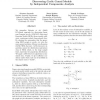Free Online Productivity Tools
i2Speak
i2Symbol
i2OCR
iTex2Img
iWeb2Print
iWeb2Shot
i2Type
iPdf2Split
iPdf2Merge
i2Bopomofo
i2Arabic
i2Style
i2Image
i2PDF
iLatex2Rtf
Sci2ools
112
Voted
UAI
2008
2008
Discovering Cyclic Causal Models by Independent Components Analysis
We generalize Shimizu et al's (2006) ICA-based approach for discovering linear non-Gaussian acyclic (LiNGAM) Structural Equation Models (SEMs) from causally sufficient, continuous-valued observational data. By relaxing the assumption that the generating SEM's graph is acyclic, we solve the more general problem of linear non-Gaussian (LiNG) SEM discovery. LiNG discovery algorithms output the distribution equivalence class of SEMs which, in the large sample limit, represents the population distribution. We apply a LiNG discovery algorithm to simulated data. Finally, we give sufficient conditions under which only one of the SEMs in the output class is "stable". 1 Linear SEMs Linear structural equation models (SEMs) are statistical causal models widely used in the natural and social sciences (including econometrics, political science, sociology, and biology) [1]. The variables in a linear SEM can be divided into two sets, the error terms (typically unobserved), and the...
Related Content
| Added | 30 Oct 2010 |
| Updated | 30 Oct 2010 |
| Type | Conference |
| Year | 2008 |
| Where | UAI |
| Authors | Gustavo Lacerda, Peter Spirtes, Joseph Ramsey, Patrik O. Hoyer |
Comments (0)

